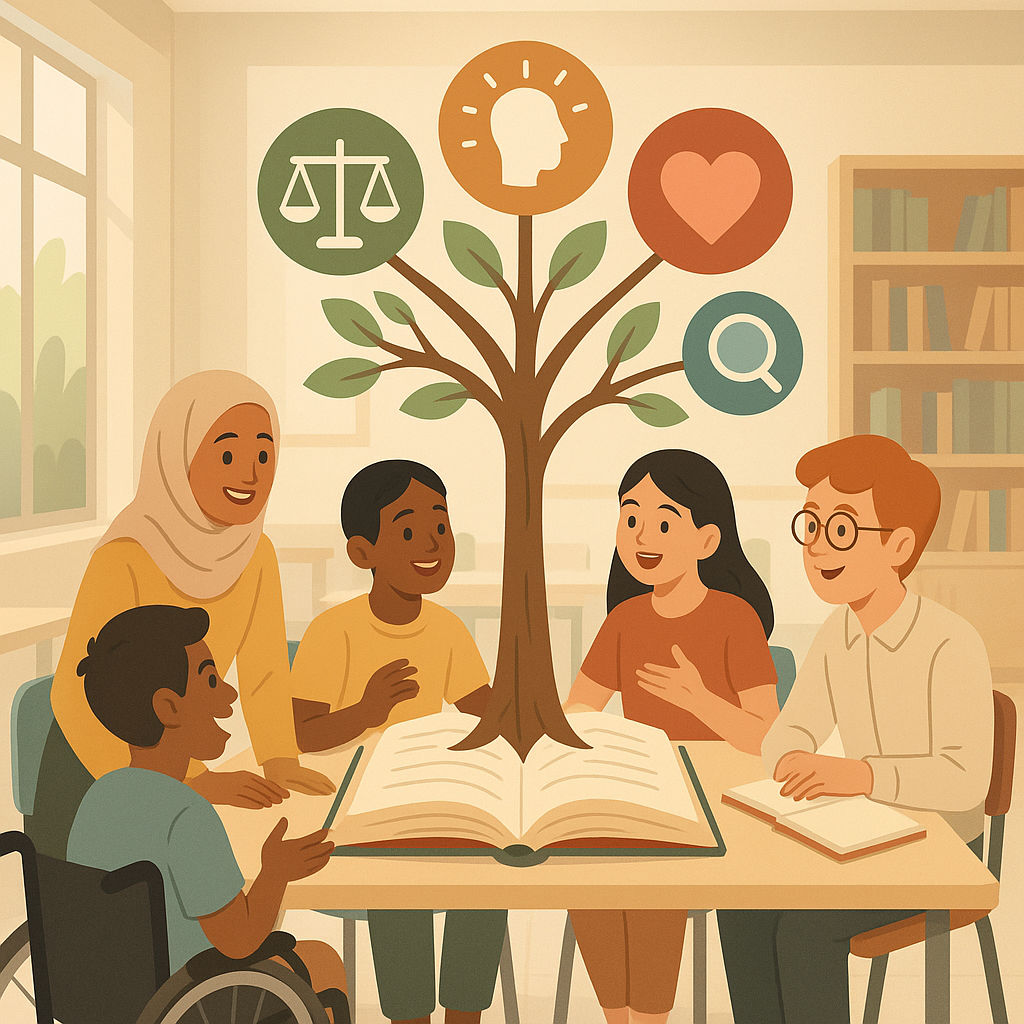Developing Critical Consciousness to Promote School Inclusion

Today’s school environments are increasingly diverse and complex. This diversity is shaped by the interplay of factors, such as nationality, ethnicity, language, religion, migration backgrounds, physical and learning disabilities, gender differences, and local traditions (Juvonen et al., 2019; Vertovec, 2007, 2010).
Despite long-standing evidence of the social, academic and cognitive benefits of such heterogeneous environments (e.g., Gabaldón-Estevan, 2020; Odom et al., 2011), discrimination, marginalisation and social exclusion remain common, particularly affecting students from vulnerable groups – for example, ethnic minorities, migrants, and pupils with disabilities (Hes & Švecová, 2021; Juvonen et al., 2019).
To address the challenges of this complexity, it is important to foster a range of attitudes and abilities, including flexibility, contextual awareness, and exploratory thinking. Especially valuable is what has been termed “complex thinking” – the ability to understand and examine interconnected aspects of reality while avoiding simplistic or stereotypical judgments (Hargreaves, 2003; Olimpo, 2010).
Among these abilities, critical consciousness plays a key role. It refers to the capacity to examine school environments, identify the factors that contribute to social exclusion, and actively promote change towards more inclusive practices (Diemer et al., 2010; Urbani et al., 2022). Originally conceptualised by Brazilian educator Paulo Freire (1970), critical consciousness is particularly relevant in today’s educational settings. It enables young people to recognise how oppressive systems – including education itself – can sustain and reproduce inequality through implicit biases and prejudices and understand how individual and collective actions can challenge these mechanisms (Urbani et al., 2022).
This capacity is valuable not only for individuals in vulnerable or marginalised positions, but for everyone. It increases awareness of how exclusion appears and encourages action to support social justice in education (Gonzales et al., 2022).
Critical consciousness consists of three interconnected components, which should be nurtured in a complementary way within educational settings (Heberle et al., 2020):
- Critical reflection – awareness of the contextual factors that underpin injustice within learning environments.
- Critical motivation – the personal belief in one’s capacity to contribute to change, individually and collectively.
- Critical action – engaging in activities that promote structural changes in schools to support the inclusion of all learners (Watts et al., 2003; Urbani et al., 2022).
Bibliography
Diemer, M. A., Wang, Q., Moore, T., Gregory, S. R., Hatcher, K. M., & Voight, A. M. (2010). Sociopolitical development, work salience, and vocational expectations among low socioeconomic status African American, Latin American, and Asian American youth. Developmental Psychology, 46(3), 619–635.
Freire, P. (1970). Pedagogy of the Oppressed. New York: Seabury Press.
Gabaldón-Estevan, D. (2020). Heterogeneity versus homogeneity in schools: a study of the educational value of classroom interaction. Education Sciences, 10(11), 335.
González-Valencia, G., Massip Sabater, M., & Santisteban Fernández, A. (2022, May). Critical global citizenship education: a study on secondary school students. In Frontiers in education (Vol. 7, p. 867113). Frontiers Media SA.
Hargreaves, A. (2003). Teaching in the knowledge society: Education in the age of insecurity. Teachers College Press.
Heberle, A. E., Rapa, L. J., & Farago, F. (2020). Critical consciousness in children and adolescents: A systematic review, critical assessment, and recommendations for future research. Psychological Bulletin, 146(6), 525.
Hes, A., & Švecová, M. (2021). The effects of globalization and the sharing economy on the intercultural communication of the young generation. In SHS Web of Conferences (Vol. 92, p. 05008). EDP Sciences.
Juvonen, J., Lessard, L. M., Rastogi, R., Schacter, H. L., & Smith, D. S. (2019). Promoting social inclusion in educational settings: Challenges and opportunities. Educational Psychologist, 54(4), 250-270.
Odom, S. L., Buysse, V., & Soukakou, E. (2011). Inclusion for young children with disabilities: A quarter century of research perspectives. Journal of early intervention, 33(4), 344-356.
Olimpo, G. (2010). Società della conoscenza, educazione, tecnologia. Italian Journal of Educational Technology, 18(2), 4-4.
Urbani, J. M., Collado, C., Manalo, A., & Gonzalez, N. (2022). Building the on-ramp to inclusion: Developing critical consciousness in future early childhood educators. Issues in Teacher Education, 31(2), 91-121.
Vertovec, S. (2007). Super-diversity and its implications. Ethnic and racial studies, 30(6), 1024-1054.
Vertovec, S. (2010). Towards post-multiculturalism? Changing communities, conditions and contexts of diversity. Vom Verstehen zur Verständigung, 43.
Watts, E. H., O'Brian, M., & Wojcik, B. W. (2003). Four models of assistive technology consideration: How do they compare to recommended educational assessment practices?. Journal of Special Education Technology, 19(1), 43-56.

